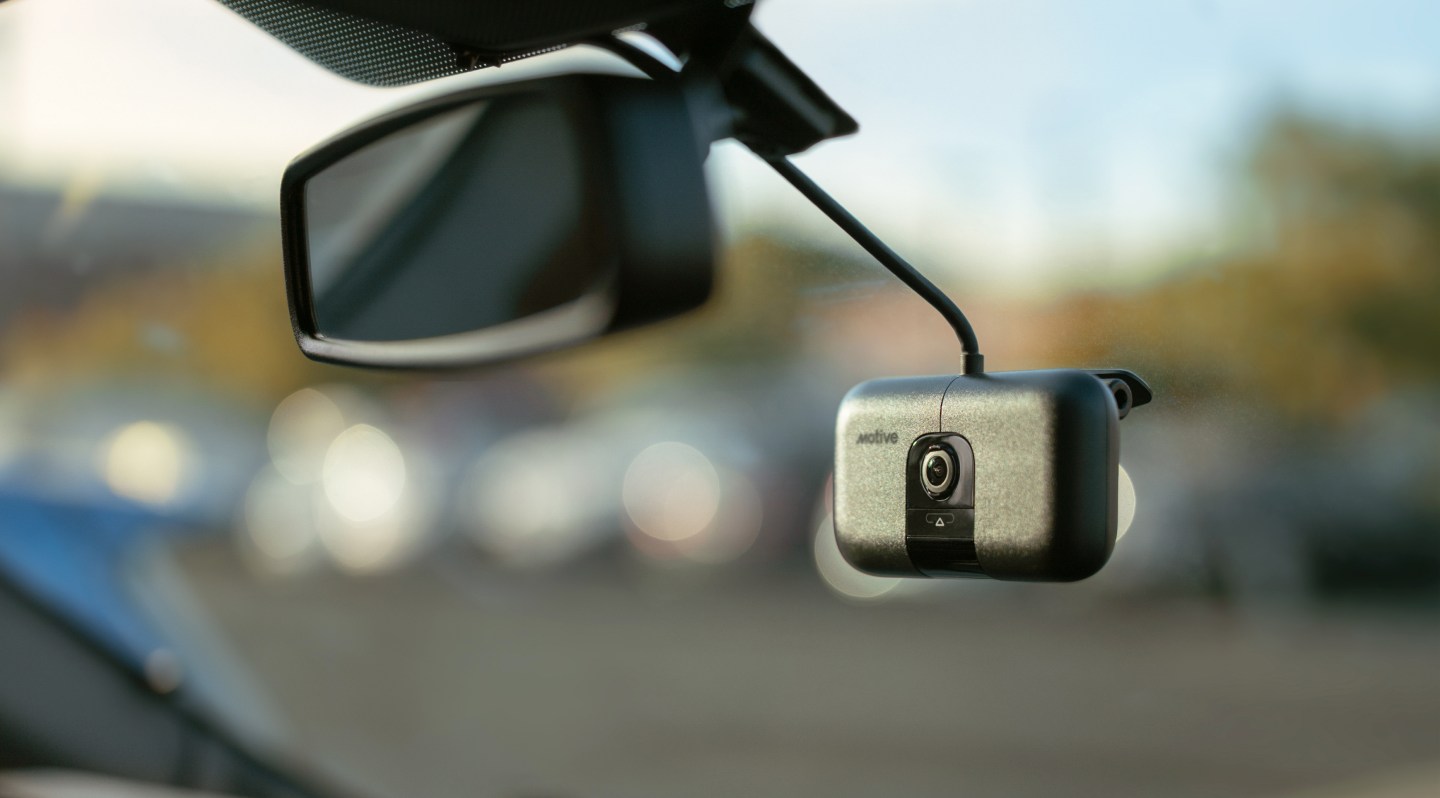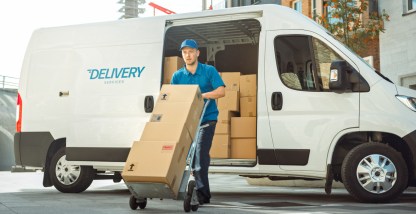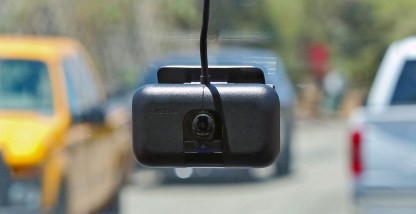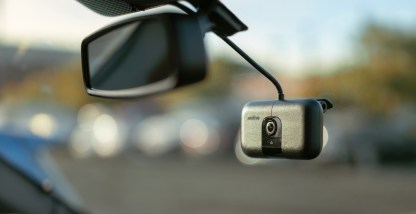Technology is transforming the transportation industry by enabling fleet optimization and improving efficiency and driver safety. One powerful tool that’s helping fleets? Dash cameras for trucks. They add a level of safety while improving driver experience and making fleet management easier. This article discusses the many benefits of dash cams for trucks and examines what to look for, legal considerations, and how to make the most of your truck dash cam technology.
Dash cams for truck basics
Dash cams have been around nearly a century. As early as 1939, you can find Popular Science coverage of a police officer with a camera on his dashboard. The cameras became increasingly common for law enforcement after the 1960s. Then, as the technology became more compact and affordable, the applications broadened.
Dash cameras for trucks can improve driver safety, lower costs, and help fleets work more efficiently. Often installed on the truck or semi-truck’s dashboard or windshield, dash cams are road-facing, driver-facing, or you can get dual-facing dash cams that record the road and the driver.
These small video cameras are typically powered by the vehicle’s electrical systems. They might turn on automatically when the ignition is started or be manually turned on and off by drivers or fleet managers.
Read: Introducing the AI camera that will help you see more.
Benefits of dash cameras for trucks
Dash cams in trucks can give safety and fleet managers more visibility into overall fleet safety. Integrating dash cam video with fleet management software gives managers insight into driver behaviors such as hard braking, hard cornering, rapid acceleration, or speeding.
Dash cam video is commonly used in the trucking industry to reveal what happened before, during, and after any incidents on the road. The truck dash camera footage can help you avoid the risk of relying on human memory or inaccurate and conflicting stories.
Video helps authorities in understanding who’s at fault in an accident. Additionally, insurance companies and courts can use the dash cam footage to determine who should pay damages and how much. For fleets, video of an incident may also be used to exonerate drivers and avoid nuclear verdicts.
California-based Nybll, for example, benefitted from Motive dash cam technology when one of its drivers was involved in a collision. Recorded footage proved the driver wasn’t at fault, which exonerated him and saved the company an estimated $500,000.
Having a dash cam in your trucks can also lower your insurance costs. Having dash cam footage helps protect your drivers’ motor vehicle records, which can lower rates.
Truck dash cameras also support your fleet’s culture of safety. Video is often used to coach drivers to improve performance. Drivers are also more motivated to follow the rules and best practices, knowing they are recorded on video. Additionally, you can use the dash cam footage, combined with other fleet management metrics, to recognize and reward your safest commercial drivers.
Advantages of AI-powered dash cameras for trucks
Dash cams that use artificial intelligence (AI) are a more recent innovation offering even more benefits. AI dash cams for trucks use real-time data to analyze road conditions and driver behavior.
These cameras can help reduce distracted driving and prevent accidents. Combining the processing power of AI and advanced computer vision algorithms, these powerful dash cams can detect unsafe driving behaviors and notify drivers of risk. In-cab audio and visual alerts can warn the driver against speeding or close following so that they will change their behavior when it matters most — while they’re on the road.
At the same time, AI analysis of dash-cam footage can help fleets to focus their coaching and training efforts. With the dash cam view, those doing the training can see the same thing that drivers see. So, even when you’re not on the road with your drivers, you can review dash cam footage together and address unsafe driver habits.
Key features to look for in truck dash cameras
There are several factors to consider when selecting the right dash cams for truckers or semi-trucks. We’ll discuss some of the main ones in this section.
File storage
You’ll want to investigate both how the dash cam footage is stored and for how long. Typically you’ll be choosing between cloud storage and memory card (or micro SD card). While cloud storage can generally hold a high volume of footage, with memory cards you’ll be limited by the specific capacity of that storage.
Connecting your dash camera video recordings to the cloud also removes the need to manually retrieve your footage. The Internet-connected truck dash cam can be set up to back up on a consistent schedule. Drivers may also send important videos to the back office when they need.
Video quality
You’ll want to be able to see clearly what is happening on the road, or both on the road and in the cab (with a dual-facing option). Video resolution will play a role in your ability to identify people and objects in the clips you review. Truck dash cams with a wide dynamic range (WDR) and wide-angle lens offering HD resolutions can help you see important details.
Smart features
As dash cam technology evolves, you can also look for smart features that can make coaching and other operational activities easier. You might seek out an offering that provides:
- GPS data integration to provide additional context.
- Reporting capabilities.
- ELD integration.
Combining AI footage with analytical interpretation, you can detect upcoming route complications, reroute vehicles to alternative routes, and better understand driving patterns and how they impact fuel consumption and vehicle performance.
Accuracy
When it comes to accident prevention and road safety, dash cam accuracy is critical. In an independent evaluation by leading research firm Strategy Analytics, the Motive AI Dashcam outperformed other leading dash cams. In 342 separate tests under daytime, dusk, and nighttime conditions, the Motive AI Dashcam successfully detected unsafe driving behavior 89% of the time, higher than Lytx (61%) and Samsara (15%).
Ease of installation
Your investment in this technology will only pay off if your drivers can easily set up and install the dash cams. You’ll encounter dashboard cameras that use adhesives or suction cups. Quick and secure adhesive options are often a good choice.
Legal considerations for truck dash cameras
When installing dash cameras in trucks, you’ll want to do some research to ensure you comply with federal and state laws. At the federal level, driver-facing dash cams are allowed, but as there are restrictions on recording someone’s voice or image without their consent, fleets must let employees know how they’re using these dash cams.
At the state level, there will be different requirements. You will need to look into the legality of the cameras and whether there are rules about where cameras can be placed. This useful resource gives state-by-state summaries of the regulations for dash cams in trucks.
Drivers may also resist installing dash cams in their trucks. If that’s the case, be sure to review best practices to encourage their buy in. It also helps to select a dash cam that supports driver privacy. For example, the Motive AI Dashcam gives drivers the option to disable the driver-facing camera while they’re off duty.
Installation and Maintenance of truck dash cameras
When installing a truck dash camera properly, you’ll want to first find the best position. Typically this is the top center of the windshield or to the side of the rearview mirror. You do not want to obscure the driver’s view. Clean the windshield of debris before applying the dash cam. Then, after pressing the camera to the windshield for at least 15 seconds, check that you have a strong connection. Next, ensure the camera is positioned correctly and functioning properly.
You may also have to attach wiring to connect the dash cam to your other onboard fleet management safety technology or to power the device. If you need help connecting your AI Dashcam to Motive’s Vehicle Gateway, for instance, contact our customer service for support.
You’ll want to invest in a durable dash cam to provide reliability. You can get heavy or extreme-duty dash cams and those with IP68 (waterproof and dustproof) cases. You’ll also need to keep your windshield clean and keep wiper blades in good shape to ensure clear images.
If you have a truck dash cam using a memory card, you’ll also want to make sure you’re using properly formatted cards that still have storage space. It’s also important to keep your dash cam’s firmware updated. If your manufacturer sends out a new release, don’t put off installing it. These updates are sent to fix bugs and enhance your features.
Reducing risk with Motive’s AI Dashcam
There are many options out there for truck dash cameras. Take the time to consider Motive’s enhanced AI safety platform. Our AI Dashcam offers industrial-grade reliability, 1440p crystal-clear HD video resolution, and a wide field of view for more coverage. Motive’s AI Dashcam also features up to 104 hours of camera storage and a built-in Quick Capture button.
You can also benefit from Motive’s advanced event intelligence technology. Our in-house safety team analyzes every AI Dashcam video quickly to determine the context and severity of each event. We filter out videos that don’t represent actual risk and prioritize the remaining footage based on risk level. This empowers safety departments and drivers to operate more efficiently.
Take a tour of our AI Dashcam for trucks today.









